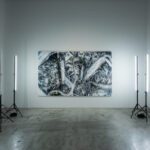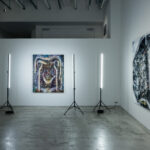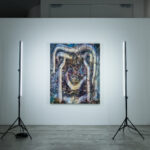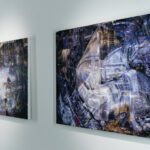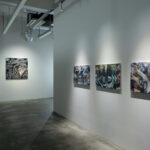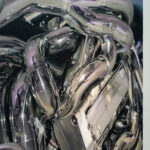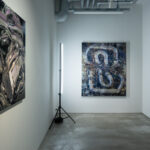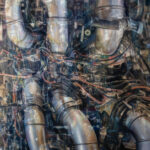Exhibition
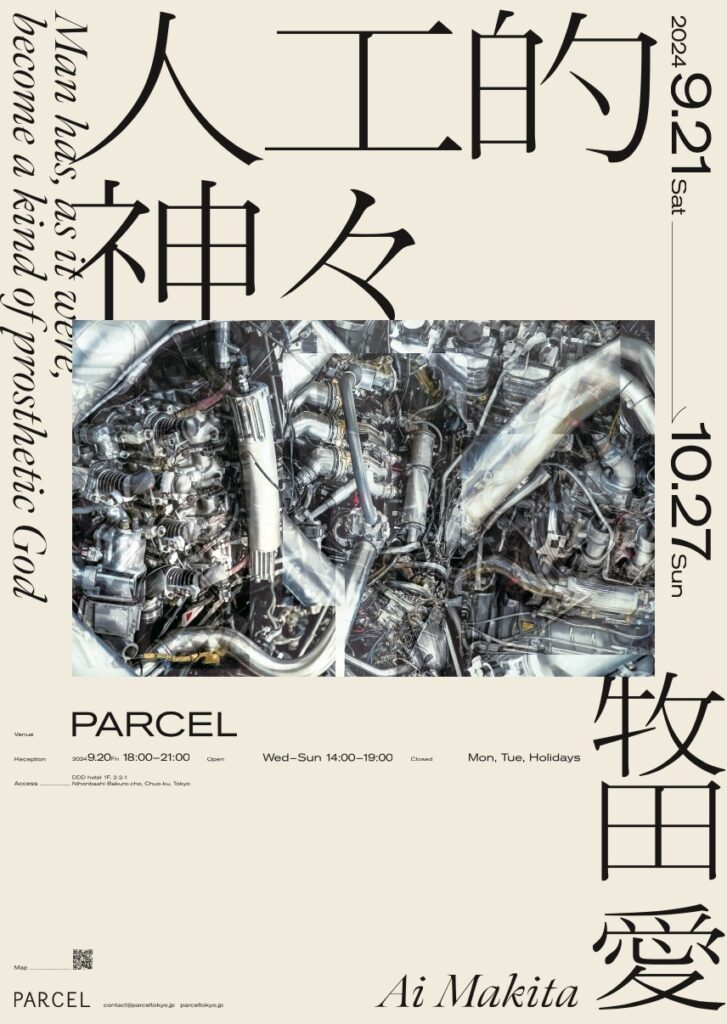
Past
2024
09.21Sat
2024
10.27Sun.
PARCEL
Open on Wed - Sun
14:00 - 19:00
Closed on Mon, Tue, National Holidays
Opening reception on September 20th, Fri. 18:00-21:00
人工的神々 -Man has, as it were, become a kind of prosthetic God-
牧田 愛|Ai Makita
details - JP
この度、PARCELでは牧田愛による待望の初個展「人工的神々 -Man has, as it were, become a kind of prosthetic God- 」を開催いたします。本展では、技術と人間の共生によって生まれた超現実的な抽象画が展示されます。
牧田の作品は、技術の進化が社会に及ぼす影響とその倫理的な使用に対する深い考察から生まれ、特に歴史的な事件や事故、技術の人為的な誤用が引き起こした悲劇が彼女の創作活動に大きな影響を与えています。技術の進歩は、利便性の追求の一方で、時としてその適用が社会に深刻な影響を及ぼすことがあります。その技術の象徴的なモノとしてのエンジンや機械機構が彼女の作品では描かれていますが、人によって設計されたのにも関わらず、意図しないエラーによって引き起こされるイレギュラーに惑わされる社会を揶揄しているように思えます。
人工知能や機械学習技術の急速な発展は今日の社会に新たな課題を生んでいます。仕事が奪われる脅威や、人工知能自体の人格化といったことが議論されていますが、牧田も他の多くの作家同様この問題に対して、これら技術(道具)としてどのように活用するかが重要であると考えており、技術の進化がもたらす新たな芸術的対話と批評的構造を提示しています。
さらには牧田が機械やエンジンを描き始めた初期からの特徴として視点の誘導が挙げられますが、画面上に立体的に絡み合っている要素はそのほとんど同一レイヤー上にあり、奥行きといった視覚的なヒエラルキーを取り除いています。特に今回の牧田の生成された画像をベースにした作品群は伝統的な西洋絵画における明暗や遠近によって生み出されるフォーカスポイントよりも、浮世絵にも見られる平面的に広がった視点誘導に近く、構成要素のサイズも誇張され歪められ、尺度が現実に即していないからこそよりリアルに見える機械風景を提示してくれるのです。
本展「人工的神々」では、牧田愛がMidjourney、DALL-E 2、ChatGPTなどのツールを駆使ししながらもエンジンやパイプ、無機質な都市の風景など今まで同様のモチーフをベースにした作品を展示します。ただし、画像生成されたイメージと現実の間には予期せぬミストランスレーションがあり、それを巧みに取り入れながら牧田は、生成された素材に対して自らの美的・形式的基準を適用し、最終的なペインティングを創り上げるというプロセスを通じて技術、AIと人間の関係性を深く掘り下げているのです。
機械学習による画像生成技術の衝撃はカメラオブスキュラの発明に近い変革をもたらすものと言えます。景色をありのまま写すことができるカメラオブスキュラは西洋絵画を、その主たる目的だった写実性から解放しました。解放された絵画はその後、印象派や抽象画へと発展、写実よりオリジナルな発想が重視され始めたことは広く知られております。機械学習は、想像を画としてアウトプットするという制作においてヒトに頼っていた部分を圧倒的なスピードと量で代替するものです。まだその使い方も技術確立も定まっておらず、多くの作家が今自身の作品との適応を模索しております。機械の力を使いながらバーチャルの中でしか存在しない機械のイメージを作り出している本展「人工的神々」では、鑑賞者は二次元から四次元にわたる視覚体験を通じて、人工と自然、生命と非生命の境界を意識することができます。牧田愛の作品は、人工知能と人間の協働による美の探求を通じて、新たな美的対話と批評的視点を提供します。観る者は、技術と人間の創造性が交錯する瞬間を体感し、技術がもたらす新たな可能性について深く考える機会を得ることでしょう。
details - EN
PARCEL is pleased to present the anticipated solo exhibition by Ai Makita, titled ‘Artificial Gods – Man has, as it were, become a kind of prosthetic God.’ This exhibition features a collection of surreal abstract paintings born from the symbiosis between technology and humanity.
Makita’s works stem from a profound reflection on the impact of technological advancement on society and its ethical implications. Her creative process is particularly influenced by historical incidents, accidents, and the tragedies resulting from the deliberate or inadvertent misuse of technology. While technological advancement often seeks to enhance convenience, its applications can sometimes have serious repercussions on society. In her paintings, Makita depicts engines and mechanical structures as symbolic representations of technology. Despite being meticulously designed by humans, these creations often cause unintended errors that disrupt society, reflecting a subtle critique of our collective vulnerability to such irregularities.
The rapid development of artificial intelligence and machine learning technologies presents new challenges in today’s society. While there are debates about the threats of job displacement and the personification of AI itself, Makita, like many other artists, believes that the crucial issue is how we utilize these technologies as tools. Her work introduces new artistic dialogues and critical frameworks that explore the implications of technological evolution.
One of the defining features of Makita’s work since she began depicting machines and engines is her manipulation of perspective. The elements that appear intricately intertwined on the canvas exist primarily on the same layer, removing any sense of depth or visual hierarchy. In her latest series, based on generated images, the compositions guide the viewer’s gaze in a way that is more akin to the flattened perspective found in ukiyo-e, rather than focusing on the chiaroscuro or vanishing points typical of traditional Western painting. The sizes of the elements are exaggerated and distorted, presenting mechanical landscapes that appear more real precisely because their scale defies reality.
In this exhibition, Makita showcases works that employ tools such as Midjourney, DALL-E 2, and ChatGPT, while still drawing on her signature themes of engines, piping, and the stark imagery of inorganic urban landscapes. However, there are unforeseen mistranslations that occur between the AI-generated images and reality. Makita skillfully incorporates these discrepancies, applying her own aesthetic and formal standards to the generated material. Through this process, she delves deeply into the complex relationship between technology, AI, and humanity, ultimately creating her final paintings.
The impact of machine learning for image generation has sparked a transformation comparable to the groundbreaking changes triggered by the invention of the camera obscura. The camera obscura, which could capture scenes as they were, liberated Western painting from its primary goal of realism. Once freed, painting evolved into movements like Impressionism and Abstract Art, where original expression began to take precedence over realism—a development widely recognized today. Machine learning now replaces the human element in producing imagined images with unprecedented speed and volume. As this technology and its uses remain in flux, many artists are currently exploring how to integrate it into their own work. Makita creates machine images that exist solely in the virtual realm, harnessing the power of technology. Viewers are invited to experience a visual journey spanning from two to four dimensions, making them conscious of the boundaries between the artificial and the natural, the living and the non-living. Through her works, Makita offers a new aesthetic dialogue and critical perspective born from the collaboration between artificial intelligence and human creativity. The audience will have the opportunity to witness the moment where technology and human creativity intersect, prompting a deeper reflection on the new possibilities that technology can bring.
展覧会、各作家、作品等に関するお問い合わせはcontact@parceltokyo.jp までお願いいたします。
For further information regarding this exhibitions or the artists, artworks please contact us at contact@parceltokyo.jp
牧田 愛|Ai Makita
1985 千葉市に生まれる
2008 筑波大学芸術専門学群美術専攻洋画コース 卒業
2013 東京藝術大学大学院芸術学専攻美術教育研究科 修了
1985 Born in Chiba, Japan
2008 Tsukuba University, B.F.A. in Art and Design
2010 Tokyo Gakugei University, M.F.A. in Oil painting
2013 Tokyo University of Arts, M.F.A. in Art and Education
個展 | Solo Exhibitions
2022 Interspecies, Mitsukoshi Contemporary, Tokyo
2022 Tectonic Shifts, The Something Machine, New York
Species, Tsutaya Book Gallery Roppongi, Tokyo
2021 Luminous Beings, haku Kyoto, Kyoto
Hyperdimension, mhPROJECTnyc, New York
2020 Artifact, Mitsukoshi Nihombashi, Tokyo
2019 Ai Makita solo exhibition, Chiba bank gallery, Tokyo
2018 Reflect on 10 years- Ai Makita”, Karuizawa New Art Museum, Nagano
2017 Gradation, Gallery Vask, Manila
Moving, Gallery Inage, Chiba
2015 Behave As a Named Existense, Roentgen Kunst Institut von Tsutomu Ikeuchi Gallery AG, Tokyo
2013 13・17, Ai Kowada Gallery, Tokyo
SIGNS OF LIFE”, Isetan Shinjuku, Tokyo
2012 jewels, Gallery Kunimatsu, Tokyo

